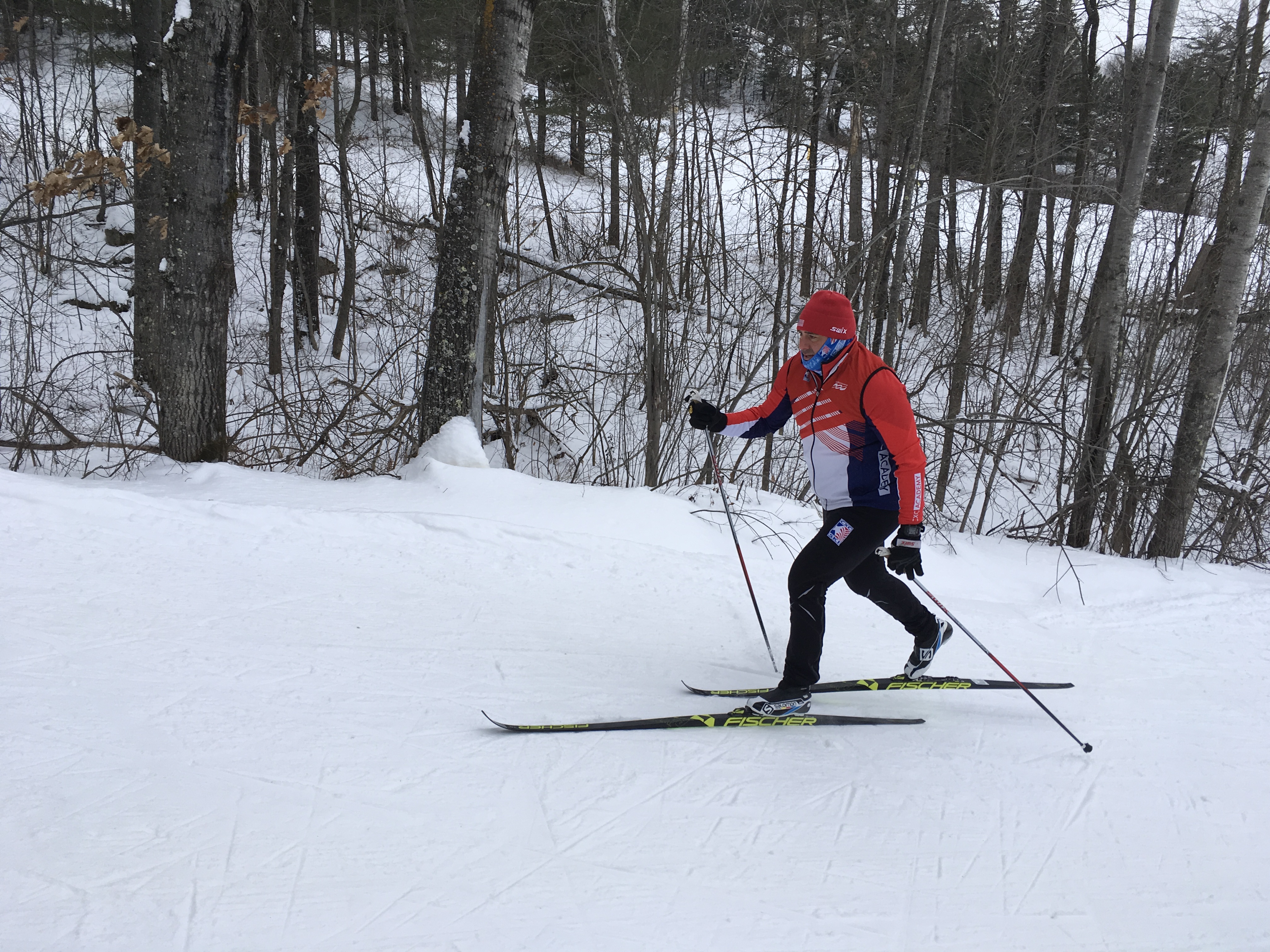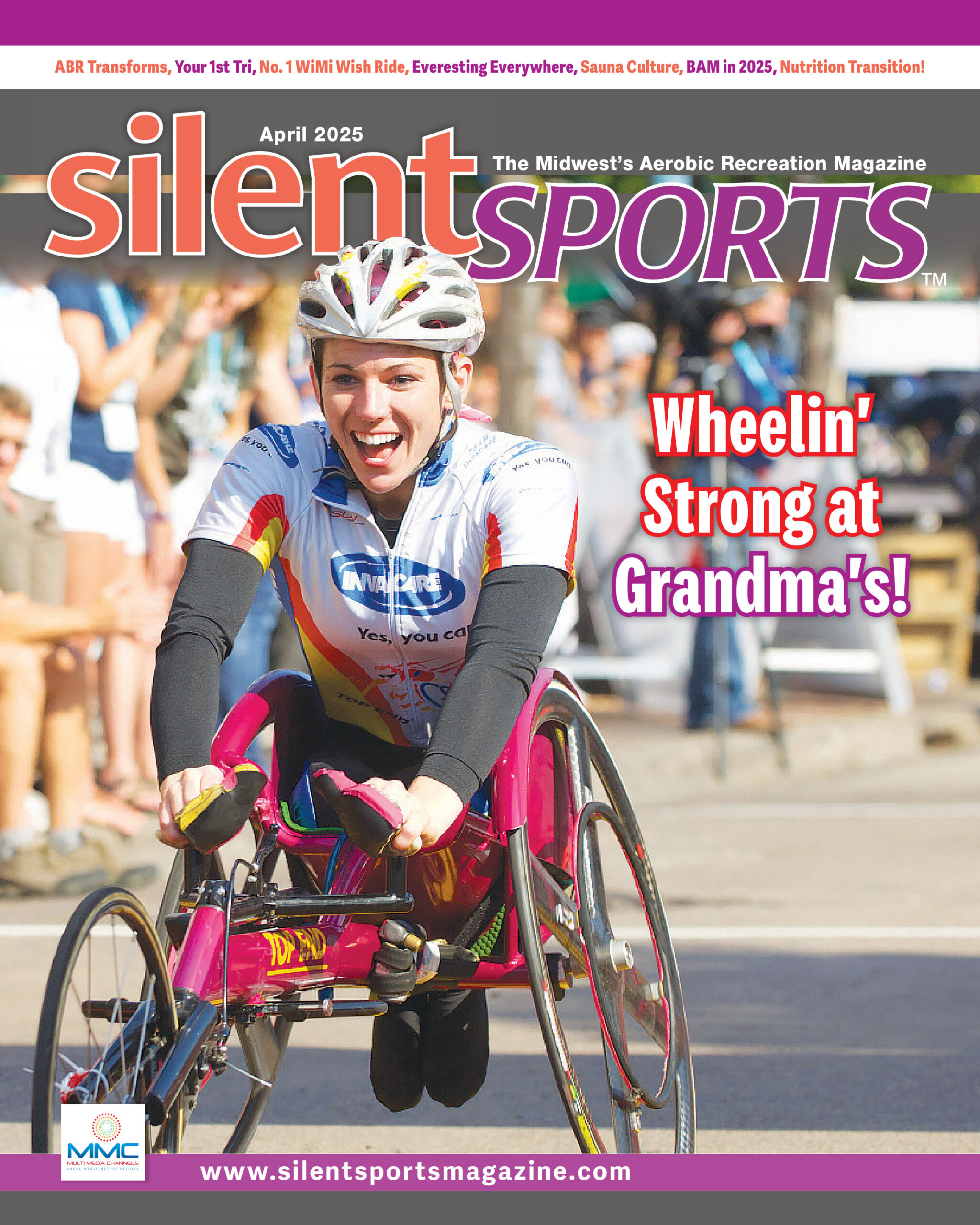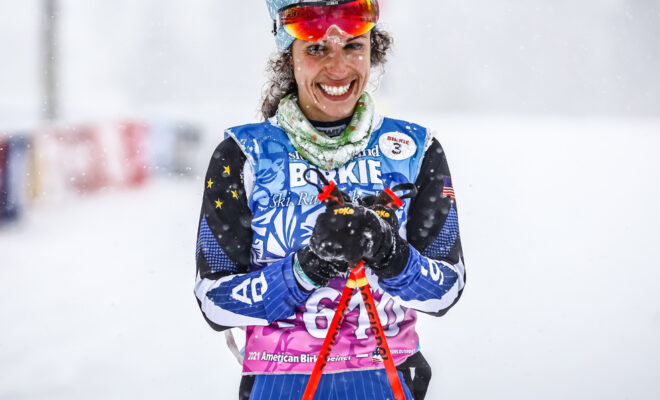Embrace the shuffle stride for Birkie classic

Joe Haggenmiller and Charlie Dee
Editor’s Note: Kortelopet skiers should check out the February, 2017, Silent Sport article that reviews the new Kortelopet Trail from OO to Hayward. You can do that by CLICKING HERE.
Charlie Dee: I’ve only skated the Birkie, Joe, but since the classic-only Birkie trail was completed in 2009, the number of Birkie striders has been steadily increasing, so why don’t we show classic skiers some love and devote this article to them?
Joe Haggenmiller: Sounds good. I’ve raced about five classic Birkies and coached skiers in many more, but I’m always amazed at how few skiers actually take advantage of the Birkie’s terrain.
CD: Take advantage?
JH: Too many skiers approach the challenging terrain as if they’re going for a relaxed ski on a rather flat golf course. I love to kick and glide as much as the next person, but our Birkie trail doesn’t offer a great deal of rhythm skiing. The dominant character is punchy climbs followed by descents, followed by more punchy climbs.
CD: Other than training on hills and expecting pain, how can a skier “take advantage” of such a hilly course?
Five Classic Gears
JH: The best thing beginning and intermediate skiers can do is expand their repertoire of classic techniques. Then all skiers, even those in the elite wave, need to practice transitions from one technique to another. The Birkie classic is all about shifting all five gears without grinding or flipping the chain, depending on whether you prefer car or bike analogies.
CD: Let’s stick with bike analogies since car stick-shifters like me are a dying breed. But I’m aware of only four classic gears: the lowest is the herringbone for really steep hills, then the basic kick and glide that is the bread and butter gear, the kick-double-pole is third gear for gradual declines and then double-pole only is high gear that takes us down gradual hills.
JH: If you’re not too old to learn new tricks, Charlie, think of an additional gear – the shuffle stride. It’s actually second gear, a quicker-paced and more compressed version of the kick and glide. Basically it’s the gear you use to keep momentum as a hill gets steeper so you can delay as long as possible leaving the tracks and herringboning.
CD: Oh, I think I do that. I’ve just never thought of it as a separate gear.
JH: You have a lot of company, but I think folks can improve their efficiency on a challenging course like the Birkie if they visualize the shuffle-stride as a distinct gear, then practice it in conjunction with their other gears.
CD: In a future article, we should systematically go through each of the five gears of classic skiing, but for now, let’s focus on how striders can refine their training over the next few weeks to achieve a more efficient Birkie.
Dump Herringbone, Load Shuffle Stride
JH: First gear, the herringbone, is a necessary gear for many people on the steepest hills. This is when skis are splayed in a wide “V” and a skier single-sticks behind each ski. However, it’s also the slowest gear. The more we’re able to avoid it, the faster we’ll get to Hayward for our Main Street celebrations.
CD: It’s exhausting to lose rhythm and be forced to leave the classic tracks and herringbone. Since I have oft-injured and arthritic ankles, herringboning is also a major source of pain for me. I’m forever grateful to the late Igor Badamshin, a predecessor to you as CXC coach, who taught me to classic ski well enough that I could cut out about 70 percent of my herringboning.
JH: That should be a goal for everyone, especially with all the steep hills between Cable and Hayward. Striders should work from now till the third week of February on minimizing their herringboning by maximizing their shuffle striding.
CD: I know one of the keys to shuffle striding is to fight the tendency to lean the upper body forward as the hill gets steeper.
JH: Exactly. Visualize yourself looking 10 yards or more ahead of you on a hilly trail, rather than looking down at your feet. This will keep you in a tall and productive body position, even on the steepest hills. But body position alone won’t keep you in the tracks. Essentially, the shuffle stride is a shorter, quicker gear than the kick and glide you do on level terrain, so tempo is key here.
Shorter Striding and Poling, Quicker Pace
JH: The steeper the hill, the shorter your glide will be naturally, due to gravity, but instead of bailing out to the herringbone when you feel you can no longer continue an elegant and picture-perfect long kick and glide, concentrate on a quicker pace with shorter strides. As you bend your knees to roll off your toes and kick, make sure your butt is going down, not back.
CD: What’s different about the poling?
JH: You also quicken your poling cadence and shorten your follow-through so that your arms don’t extend beyond your hips. Sometimes you don’t even get to your hips. Also, the angle of your pole relative to the snow will be reduced by the steep hill, but I see some people trying to force 90-degree angles at their shoulders and elbows, which is self-defeating. It’s fine, and actually natural, to reduce those angles as the hill steepens, and these reductions are necessary to achieve a quicker pace.
CD: OK, it makes sense that if a skier can throw in three to five shuffle strides on each steep hill before leaving the tracks, that means less herringboning and more energy reserved.
JH: Also, even in Wave 6, if skiers are comfortable with the shuffle stride, they should never need to leave the tracks in the more gradual terrain after the classic trail joins the skate trail beyond OO. Simply kick and glide until the hill is too steep, then use a short shuffle to the top, kick-double-pole over the top, glide down the other side, and repeat.
Find Terrain, Practice Transitions
CD: You say “simply,” but of course downshifting or upshifting gears doesn’t go smoothly without a lot of practice. What can people do in the next three weeks to get comfortable and confident?
JH: From now until the Birkie, find a trail that offers terrain as similar as possible, with 20 to 50 transitions from one technique to the other in around 5 kilometers: the Ski Silver course at Giants Ridge in the arrowhead of Minnesota, the Hap and Judy 5k at Wirth Park in Minneapolis, the NARA Trails at Michigan Tech in the Keweenaw, Hautanen Highlands at ABR in Ironwood, the Upper Black Loop at Lapham Peak near Milwaukee and the Green loop at Greenbush in the Northern Kettle Moraine are a few good examples of good trails to be used.
CD: I assume the key is not only getting comfortable with the shuffle stride, but also getting used to down-shifting from kick and glide to the shuffle stride, as well as up-shifting back to the kick and glide when the terrain subsides?
Push Limits to Discover Sweet Spot
JH: That and more. The key to training on transitions between techniques is to discover what your comfort level is with each gear so that the shifts come easily and naturally, even when you’re fatigued. Experiment with sticking too long with the shuffle stride and discover where the point is when you lose momentum, and are forced to herringbone. Repeat at that same spot on the trail several times. You may discover that you can last much longer in the tracks then you ever imagined.
CD: And take the same approach to pushing the limits of your kick and glide before downshifting into the short shuffle?
JH: Of course. There are two climbs towards the end of the race where striders who practice this gear-shifting can gain an advantage. Coming out of Fish Hatchery there’s a long, gradual climb, and then after a gradual downhill, the trail crosses Highway 77 and another climb starts. Both offer long, gradual ascents that seem steeper than they are because of where they come in the race. If you still have gas sloshing in your tank and can summon the energy, try to stride and glide as long as possible before breaking into the shuffle stride. If you can stay technically smooth, these are excellent spots to pass people who are fading.
CD: And then double-pole down to Duffy’s Field, knowing all you have left is Lake Hayward, then Main Street cowbells. When we do a future piece on all five gears, we’ll go into detail on refining the double-pole as well as the kick-double-pole.
JH: Until then, working on the shuffle stride and transitions will bring those cowbells a bit sooner.


